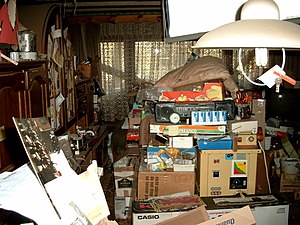Compulsive hoarder
| Compulsive hoarding | |
|---|---|
 |
|
| Compulsive hoarding in an apartment | |
| Classification and external resources | |
| Specialty | Psychiatry |
| MeSH | D060845 |
Compulsive hoarding, also known as hoarding disorder, is a pattern of behavior that is characterized by excessive acquisition and an inability or unwillingness to discard large quantities of objects that cover the living areas of the home and cause significant distress or impairment. Compulsive hoarding behavior has been associated with health risks, impaired functioning, economic burden, and adverse effects on friends and family members. When clinically significant enough to impair functioning, hoarding can prevent typical uses of space, enough so that it can limit activities such as cooking, cleaning, moving through the house, and sleeping. It can also put the individual and others at risk of fires, falling, poor sanitation, and other health concerns. Compulsive hoarders may be aware of their irrational behavior, but the emotional attachment to the hoarded objects far exceeds the motive to discard the items.
Researchers have only recently begun to study hoarding, and it was first defined as a mental disorder in the 5th edition of the DSM in 2013. It was not clear whether compulsive hoarding is a separate, isolated disorder, or rather a symptom of another condition, such as OCD, but the current DSM lists hoarding disorder as both a mental disability and a possible symptom for OCD. Prevalence rates have been estimated at 2% to 5% in adults, though the condition typically manifests in childhood with symptoms worsening in advanced age, at which point collected items have grown excessive and family members who would otherwise help to maintain and control the levels of clutter have either died or moved away. Hoarding appears to be more common in people with psychological disorders such as depression, anxiety and attention deficit hyperactivity disorder (ADHD). Other factors often associated with hoarding include alcohol dependence, paranoid schizotypal and avoidance traits.
In 2008, a study was conducted to determine if there is a significant link between hoarding and interference in occupational and social functioning. Hoarding behavior is often severe because hoarders do not recognize it as a problem. It is much harder for behavioral therapy to successfully treat compulsive hoarders with poor insight about their disorder. Results show that hoarders were significantly less likely to see a problem in a hoarding situation than a friend or a relative might. This is independent of OCD symptoms, as people with OCD are often very aware of their disorder. The opposite condition is compulsive decluttering.
...
Wikipedia
